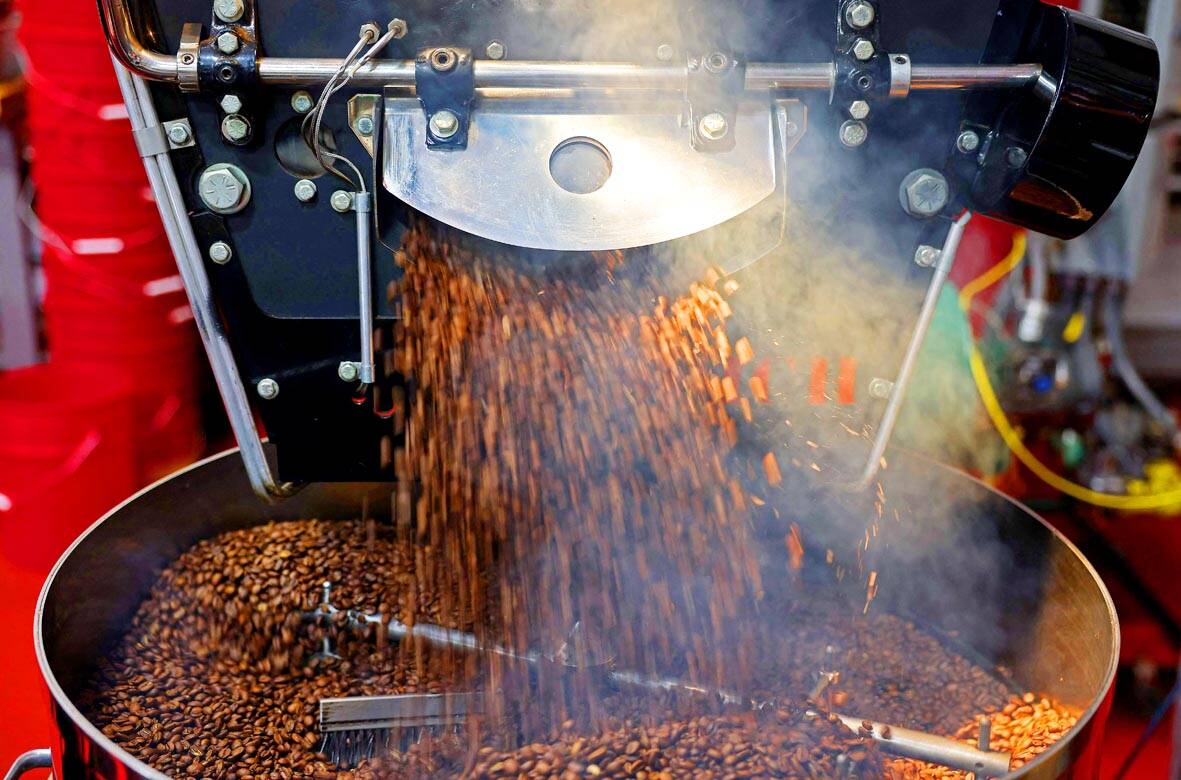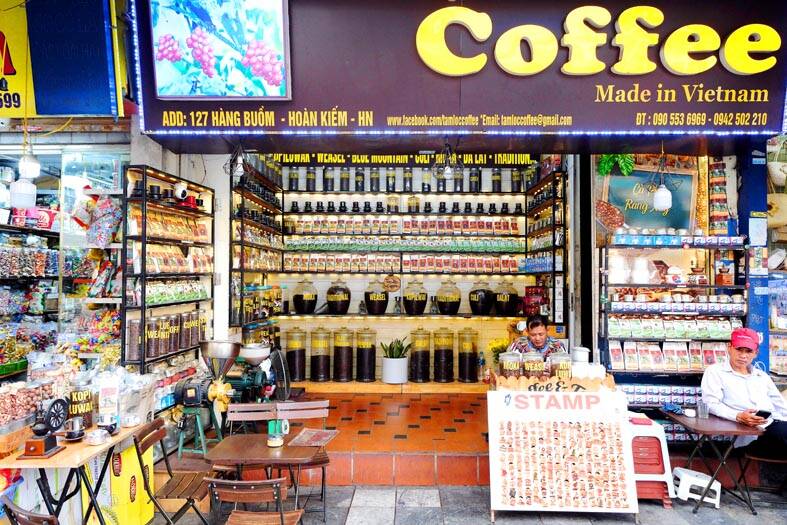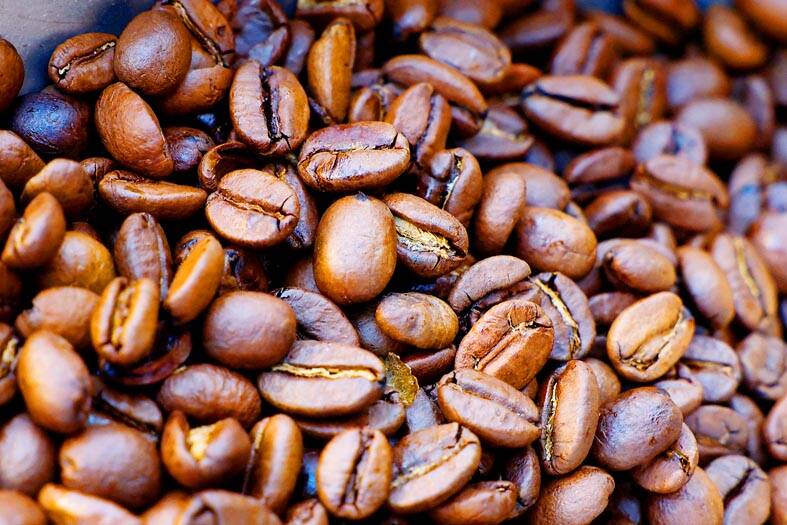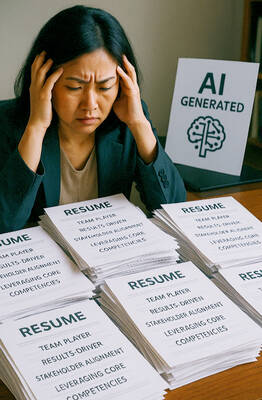Global coffee prices have soared to their highest in nearly 50 years due to poor weather in Brazil and Vietnam, forcing roasters such as Nestle to raise prices and consumers to hunt for cheaper brews amid the cost of living crisis.
Spiking prices will benefit farmers with the crop this year, but challenge traders who face crippling hedging costs on exchanges and a scramble to receive the beans they pre-bought.
WHAT DRIVES PRICES?

Photo: AFP 照片:法新社
Production problems linked to bad weather in Brazil and Vietnam have seen global supplies lagging demand for three years. That has left stocks depleted and driven benchmark ICE exchange prices to a peak of US$3.36 per lb.
Last time coffee traded that high was in 1977 when snow destroyed swathes of Brazil’s plantations. However, the shock to consumers was much bigger back then. If adjusted for inflation, US$3.36 per lb in 1977 would be equivalent to US$17.68 today.
Experts are meanwhile predicting yet another year of lackluster coffee output.

Photo: EPA-EFE 照片:歐新社
Brazil, which produces nearly half the world’s arabica — high-end beans used primarily in roast and ground blends — experienced one of its worst droughts on record this year.
Although rains finally arrived in October, soil moisture remains low and experts say the trees are producing too many leaves and too few of the flowers that turn into cherries.
In Vietnam, which produces some 40 percent of the robusta beans typically used to make instant coffee, a severe drought earlier this year was followed by excess rains since October.

Photo: Reuters 照片:路透
Consultancy StoneX sees Brazil’s arabica output falling 10.5 percent to 40 million bags next year, offset somewhat by higher robusta output, thus cutting the country’s overall crop by 0.5 percent.
In Vietnam, the crop could shrink up to 10 percent in the year by the end of September next year, adding to the global robusta shortage.
IMPACT ON ROASTERS AND CONSUMERS

Photo: Reuters 照片:路透
Surging coffee prices are a problem for roasters.
The boss of Nestle, the world’s biggest coffee firm, was ousted earlier this year after the board grew unhappy about weak sales and a loss of market share due to price rises, which prompted consumers to switch to cheaper brands.
Roasters tend to buy coffee many months in advance, which means consumers will likely see the price spike in 6 to 12 months.
Consumers who drink out will feel less of a pinch of today’s rising prices.
Roasters like Starbucks that sell mostly to cafes should fare better as the global coffee price accounts for only about 1.4 percent of the total price of a typical US$5 cup of coffee in a cafe.
(Reuters)
由於巴西和越南的惡劣天氣,全球咖啡價格飆升至近五十年來最高,迫使雀巢等烘焙商提高價格,消費者身處物價危機,也不得不去找更便宜的咖啡。
價格上漲,今年收穫的農民將會受益,但也會給交易商帶來挑戰,因為要面臨交易所高昂的避險成本,以及為已預購咖啡豆爭奪貨源的壓力。
咖啡價格飆高的原因為何?
巴西和越南的惡劣天氣,導致咖啡生產出現問題,全球咖啡連續三年供不應求。這讓咖啡庫存枯竭,並將洲際交易所(ICE)的交易基準價推至每磅3.36美元的高峰。
上一次咖啡交易價達到如此之高是在1977年,因大雪摧毀了巴西大片咖啡農場。但當時對消費者的衝擊要大得多。若根據通貨膨脹換算,1977年每磅3.36美元相當於今天的17.68美元。
專家同時也預測咖產量低迷的情況還會再持續一年。
巴西生產了世界近一半的阿拉比卡咖啡豆(主要用於烘焙及研磨調和的高級咖啡豆),但巴西今年經歷了有史以來最嚴重的乾旱之一。
雖然10月終於迎來了降雨,但土壤濕度仍然很低,專家表示,咖啡樹長出的葉子太多,而能結出果子的花朵卻太少。
通常用於製造即溶咖啡的羅布斯塔咖啡豆,約40%出產自越南,越南今年稍早遭逢嚴重乾旱,然後從10月起又出現了過量降雨。
顧問公司StoneX預估,明年巴西的阿拉比卡咖啡產量將下降10.5%,至四千萬袋,但羅布斯塔咖啡產量將會增加,多少會抵銷一些影響,因此巴西的咖啡總產量將減少0.5%。
在越南,到明年9月底,全年產量可能會減少10%,加劇羅布斯塔咖啡豆的全球短缺。
對烘焙商和消費者的影響
咖啡價格飆升對烘焙商來說是個問題。
全球最大咖啡公司雀巢的執行長今年稍早被罷免,因為董事會不滿銷售疲軟以及價格調漲,使消費者轉向更便宜的品牌,導致雀巢的市占率下滑。
烘焙商通常會提前數月購買咖啡,這意味消費者可能會在6至12個月內看到咖啡價格飆升。
外出喝咖啡的消費者比較不會因現今咖啡價格上漲而感到壓力。
像星巴克這樣主要向咖啡館銷售的烘焙商應該會表現得更好,因為在咖啡館典型的5美元一杯咖啡中,全球咖啡價格因素只佔總價的1.4%左右。
(台北時報林俐凱編譯)

In an effort to fight phone scams, British mobile phone company O2 has introduced Daisy, an AI designed to engage phone con artists in time-wasting conversations. Daisy is portrayed as a kindly British granny, exploiting scammers’ tendency to target the elderly. Her voice, based on a real grandmother’s for authenticity, adds to her credibility in the role. “O2” has distributed several dedicated phone numbers online to direct scammers to Daisy instead of actual customers. When Daisy receives a call, she translates the scammers’ spoken words into text and then responds to them accordingly through a text-to-speech system. Remarkably, Daisy

Bilingual Story is a fictionalized account. 雙語故事部分內容純屬虛構。 Emma had reviewed 41 resumes that morning. While the ATS screened out 288 unqualified, she screened for AI slop. She could spot it a mile away. She muttered AI buzzwords like curses under her breath. “Team player.” “Results-driven.” “Stakeholder alignment.” “Leveraging core competencies.” Each resume reeked of AI modeling: a cemetery of cliches, tombstones of personality. AI wasn’t just changing hiring. It was draining the humanity from it. Then she found it: a plain PDF cover letter. No template. No design flourishes. The first line read: “I once tried to automate my

Every May 1, Hawaii comes alive with Lei Day, a festival celebrating the rich culture and spirit of the islands. Initiated in 1927 by the poet Don Blanding, Lei Day began as a tribute to the Hawaiian custom of making and wearing leis. The idea was quickly adopted and officially recognized as a holiday in 1929, and leis have since become a symbol of local pride and cultural preservation. In Hawaiian culture, leis are more than decorative garlands made from flowers, shells or feathers. For Hawaiians, giving a lei is as natural as saying “aloha.” It shows love and

1. 他走出門,左右看一下,就過了馬路。 ˇ He walked outside, looked left and right, and crossed the road. χ He walked outside and looked left and right, crossed the road. 註︰並列連接詞 and 在這句中連接三個述語。一般的結構是 x, y, and z。x and y and z 是加強語氣的結構,x and y, z 則不可以。 2. 他們知道自己的弱點以及如何趕上其他競爭者。 ˇ They saw where their weak points lay and how they could catch up with the other competitors. χ They saw where their weak points lay and how to catch up with the other competitors. 註:and 一般連接同等成分,結構相等的單詞、片語或子句。誤句中 and 的前面是子句,後面是不定詞片語,不能用 and 連接,必須把不定詞片語改為子句,and 前後的結構才相等。 3. 她坐上計程車,直接到機場。 ˇ She took a cab, which took her straight to the airport. ˇ She took a cab and it took her straight